An Automated and Efficient Slope Unit Division Method Coupled with Computer Graphics and Hydrological Principles
Abstract
1. Introduction
2. Methods
2.1. SUD-CGHP Method Workflow
- Step 1: Data Preprocessing
- Step 2: Graphical Analysis
- Step 3: Watershed Delineation
- Step 4: Region Merging and Post-processing
2.2. Implementation Process
2.2.1. Data Preprocessing
2.2.2. Graphical Analysis
2.2.3. Watershed Delineation
2.2.4. Region Merging and Post-Processing
3. Case Study
3.1. Research Areas and Data Sources
3.2. Slope Unit Extraction
4. Qualitative and Quantitative Analyses
4.1. Qualitative Analysis
4.2. Quantitative Analysis
4.2.1. Flow Direction
4.2.2. Slope Aspect
4.2.3. Slope Gradient
5. Discussion
6. Conclusions
- (1)
- SUD-CGHP not only identifies large planar areas with greater morphological regularity compared to HPAM but also avoids elongated slope units and extensive manual revision processes. This capability ensures geometric coherence while reducing post-processing efforts, making it suitable for real-world engineering applications.
- (2)
- The method exhibits superior internal consistency in flow direction, aspect, and gradient parameters across derived slope units. The findings demonstrate that the outcomes generated by SUD-CGHP represent a superior alternative for establishing geohazard evaluation units.
- (3)
- SUD-CGHP demonstrates advanced planar recognition performance and automated processing efficiency, enabling rapid and precise slope unit extraction even for large datasets. This innovative methodology represents a substantial advancement in automating geohazard susceptibility assessments, diversifying slope unit selection paradigms, and promoting theoretical integration across multiple disciplines, thereby establishing a robust methodological foundation for enhanced spatial analysis in geohazard research.
- (4)
- In the subsequent phase of this study, we will systematically investigate the predictive accuracy and optimization potential of landslide susceptibility mapping models based on slope units delineated within the Yanglousi Town study area through the integration of artificial intelligence technologies. Notably, this research will further explore the synergistic integration of slope units with raster-based approaches in geospatial analysis while elaborating on the practical implementation strategies for multiscale geospatial analysis frameworks.
Author Contributions
Funding
Institutional Review Board Statement
Informed Consent Statement
Data Availability Statement
Conflicts of Interest
Abbreviations
| HPAM | hydrological process analysis method |
| SUD-CGHP | slope unit division method coupled with computer graphics and hydrological principles |
| DEMs | digital elevation models |
| STD | standard deviation |
References
- Hadji, R.; Boumazbeur, A.; Limani, Y.; Baghem, M.; Chouabi, A.; Demdoum, A. Geologic, topographic and climatic controls in landslide hazard assessment using GIS modeling: A case study of Souk Ahras region, NE Algeria. Quat. Int. 2013, 302, 224–237. [Google Scholar] [CrossRef]
- He, S.; Pan, P.; Dai, L.; Wang, H.; Liu, J. Application of kernel-based Fisher discriminant analysis to map landslide susceptibility in the Qinggan River delta, Three Gorges, China. Geomorphology 2012, 171, 30–41. [Google Scholar] [CrossRef]
- Chau, K.T.; Sze, Y.; Fung, M.; Wong, W.; Fong, E.; Chan, L. Landslide hazard analysis for Hong Kong using landslide inventory and GIS. Comput. Geosci. 2004, 30, 429–443. [Google Scholar] [CrossRef]
- Liang, X.; Segoni, S.; Fan, W.; Yin, K.; Deng, L.; Xiao, T.; Barbadori, F.; Casagli, N. Integration of effective antecedent rainfall to improve the performance of rainfall thresholds for landslide early warning in Wanzhou District, China. Int. J. Disaster Risk Reduct. 2025, 109, 105317. [Google Scholar] [CrossRef]
- Arabameri, A.; Pradhan, B.; Pourghasemi, H.R.; Rezaei, K.; Kerle, N. Spatial Modelling of Gully Erosion Using GIS and R Programing: A Comparison among Three Data Mining Algorithms. Appl. Sci. 2018, 8, 1369. [Google Scholar] [CrossRef]
- Bi, R.; Han, Z. Experimental Investigation of the Normal Coefficient of Restitution in Rockfall Collisions: Influence and Interaction of Controlling Factors. Appl. Sci. 2025, 15, 3874. [Google Scholar] [CrossRef]
- Abramson, L.W.; Lee, T.S.; Sharma, S.; Boyce, G.M. Slope Stability and Stabilization Methods; John Wiley & Sons: Hoboken, NJ, USA, 2001. [Google Scholar]
- Warren, S.D.; Hohmann, M.G.; Auerswald, K.; Mitasova, H. An evaluation of methods to determine slope using digital elevation data. Catena 2004, 58, 215–233. [Google Scholar] [CrossRef]
- Wang, K.; Zhang, S.; Wei, F. Slope unit extraction methods: Advances and prospects. J. Chang. River Sci. Res. Inst. 2020, 37, 85. [Google Scholar]
- Chen, W.; Chen, Y.; Tsangaratos, P.; Ilia, I.; Wang, X. Combining Evolutionary Algorithms and Machine Learning Models in Landslide Susceptibility Assessments. Remote Sens. 2020, 12, 3854. [Google Scholar] [CrossRef]
- Zhang, Y.; Zhang, W.; Wang, L.; Xiao, T.; Meng, X.; Zhang, Z. Mechanism of the high-speed and long-run-out landslide considering the evolution of the frictional heat in the sliding zone. Nat. Hazards 2024, 120, 3299–3317. [Google Scholar] [CrossRef]
- Zhou, S.; Han, W.; Huang, M.; Xu, Z.; Li, J.; Zhang, J. Slope Stability Prediction Based on Incremental Learning Bayesian Model and Literature Data Mining. Appl. Sci. 2025, 15, 2423. [Google Scholar] [CrossRef]
- Schlögel, R.; Marchesini, I.; Alvioli, M.; Reichenbach, P.; Rossi, M.; Malet, J.-P. Optimizing landslide susceptibility zonation: Effects of DEM spatial resolution and slope unit delineation on logistic regression models. Geomorphology 2018, 301, 10–20. [Google Scholar] [CrossRef]
- Li, L.; Jia, M.; Xu, C.; Tian, Y.; Ma, S.; Yang, J. Enhancing Landslide Susceptibility Mapping by Integrating Neighboring Information in Slope Units: A Spatial Logistic Regression. Remote Sens. 2024, 16, 4475. [Google Scholar] [CrossRef]
- Ba, Q.; Chen, Y.; Deng, S.; Yang, J.; Li, H. A comparison of slope units and grid cells as mapping units for landslide susceptibility assessment. Earth Sci. Inform. 2018, 11, 373–388. [Google Scholar] [CrossRef]
- Liu, S.; Zhu, J.; Yang, D.; Ma, B. Comparative study of geological hazard evaluation systems using grid units and slope units under different rainfall conditions. Sustainability 2022, 14, 16153. [Google Scholar] [CrossRef]
- Zhang, M.; Gu, S. Stability Analysis of the Longitudinal Slope Linear Shield Tunnel Excavation Face. Appl. Sci. 2025, 15, 4083. [Google Scholar] [CrossRef]
- Nelson, A.; Reuter, H.; Gessler, P. DEM production methods and sources. Dev. Soil Sci. 2009, 33, 65–85. [Google Scholar]
- Mukherjee, S.; Joshi, P.K.; Mukherjee, S.; Ghosh, A.; Garg, R.; Mukhopadhyay, A. Evaluation of vertical accuracy of open source Digital Elevation Model (DEM). Int. J. Appl. Earth Obs. Geoinf. 2013, 21, 205–217. [Google Scholar] [CrossRef]
- Huang, F.; Tao, S.; Li, D.; Lian, Z.; Catani, F.; Huang, J.; Li, K.; Zhang, C. Landslide Susceptibility Prediction Considering Neighborhood Characteristics of Landslide Spatial Datasets and Hydrological Slope Units Using Remote Sensing and GIS Technologies. Remote Sens. 2022, 14, 4436. [Google Scholar] [CrossRef]
- Liu, H.; Zhang, X.; Lin, H.; Chen, Y.; Yang, C.; Ou, K. Shear Mechanical Properties of Rock Joints Under Non-Uniform Load Based on DEM. Appl. Sci. 2025, 15, 4257. [Google Scholar] [CrossRef]
- Zhou, F.; Yao, T.; Bian, J.; Xiao, Y. Improvement of Terrain Entropy Calculation for Grid Digital Elevation Models Considering Spatial Structural Features. Appl. Sci. 2025, 15, 2577. [Google Scholar] [CrossRef]
- Carrara, A.; Guzzetti, F. Geographical Information Systems in Assessing Natural Hazards; Springer Science & Business Media: Berlin/Heidelberg, Germany, 2013; Volume 5. [Google Scholar]
- Yang, Z.; Shao, W.; Qiao, J.; Huang, D.; Tian, H.; Lei, X.; Uchimura, T. A Multi-Source Early Warning System of MEMS Based Wireless Monitoring for Rainfall-Induced Landslides. Appl. Sci. 2017, 7, 1234. [Google Scholar] [CrossRef]
- Xie, M.; Esaki, T.; Zhou, G. GIS-based probabilistic mapping of landslide hazard using a three-dimensional deterministic model. Nat. Hazards 2004, 33, 265–282. [Google Scholar] [CrossRef]
- Gu, T.; Wang, J.; Fu, X.; Liu, Y. GIS and limit equilibrium in the assessment of regional slope stability and mapping of landslide susceptibility. Bull. Eng. Geol. Environ. 2015, 74, 1105–1115. [Google Scholar] [CrossRef]
- Huo, A.; Zhang, J.; Lu, Y.; Yao, Y. Method of Classification for Susceptibility Evaluation Unit for Geological Hazards: A Case Study of Huangling County, Shaanxi, China. J. Jilin Univ. (Earth Sci. Ed.) 2011, 41, 523–528+535. [Google Scholar] [CrossRef]
- Yan, G.; Liang, S.; Zhao, H. An Approach to Improving Slope Unit Division Using GIS Technique. Sci. Geogr. Sin. 2017, 37, 1764–1770. [Google Scholar] [CrossRef]
- Alvioli, M.; Marchesini, I.; Reichenbach, P.; Rossi, M.; Ardizzone, F.; Fiorucci, F.; Guzzetti, F. Automatic delineation of geomorphological slope units with r.slopeunits v1.0 and their optimization for landslide susceptibility modeling. Geosci. Model Dev. 2016, 9, 3975–3991. [Google Scholar] [CrossRef]
- Alvioli, M.; Guzzetti, F.; Marchesini, I. Parameter-free delineation of slope units and terrain subdivision of Italy. Geomorphology 2020, 358, 107124. [Google Scholar] [CrossRef]
- Wang, K.; Xu, H.; Zhang, S.; Wei, F.; Xie, W. Identification and extraction of geomorphological features of landslides using slope units for landslide analysis. ISPRS Int. J. Geo-Inf. 2020, 9, 274. [Google Scholar] [CrossRef]
- Wang, K.; Zhang, S.; DelgadoTellez, R.; Wei, F. A new slope unit extraction method for regional landslide analysis based on morphological image analysis. Bull. Eng. Geol. Environ. 2019, 78, 4139–4151. [Google Scholar] [CrossRef]
- Huang, F.; Tao, S.; Chang, Z.; Huang, J.; Fan, X.; Jiang, S.-H.; Li, W. Efficient and automatic extraction of slope units based on multi-scale segmentation method for landslide assessments. Landslides 2021, 18, 3715–3731. [Google Scholar] [CrossRef]
- Foley, J.D.; Van Dam, A.; Feiner, S.K.; Hughes, J.F.; Phillips, R.L. Introduction to Computer Graphics; Addison-Wesley Reading: Boston, MA, USA, 1994; Volume 55. [Google Scholar]
- Foley, J.D. Computer Graphics: Principles and Practice; Addison-Wesley Professional: Boston, MA, USA, 1996; Volume 12110. [Google Scholar]
- Agoston, M.K. Computer Graphics and Geometric Modeling; Springer: Berlin/Heidelberg, Germany, 2005; Volume 1. [Google Scholar]
- Zhou, K.; Hou, Q.; Wang, R.; Guo, B. Real-time kd-tree construction on graphics hardware. ACM Trans. Graph. (TOG) 2008, 27, 1–11. [Google Scholar]
- Moretti, G.; Orlandini, S. Thalweg and ridge network extraction from unaltered topographic data as a basis for terrain partitioning. J. Geophys. Res. Earth Surf. 2023, 128, e2022JF006943. [Google Scholar] [CrossRef]
- Affandi, E.; Ng, T.F.; Pereira, J.J. Integration of Geoscience Information for Disaster Resilience in Kuala Lumpur, Malaysia. Appl. Sci. 2023, 13, 7004. [Google Scholar] [CrossRef]
- Cao, J.; Zhang, Z.; Du, J.; Zhang, L.; Song, Y.; Sun, G. Multi-geohazards susceptibility mapping based on machine learning—A case study in Jiuzhaigou, China. Nat. Hazards 2020, 102, 851–871. [Google Scholar] [CrossRef]
- Ma, J.; Wang, X.; Yuan, G. Evaluation of Geological Hazard Susceptibility Based on the Regional Division Information Value Method. ISPRS Int. J. Geo-Inf. 2023, 12, 17. [Google Scholar] [CrossRef]
- Ahmad, H.; Ningsheng, C.; Rahman, M.; Islam, M.M.; Pourghasemi, H.R.; Hussain, S.F.; Habumugisha, J.M.; Liu, E.; Zheng, H.; Ni, H.; et al. Geohazards susceptibility assessment along the upper indus basin using four machine learning and statistical models. ISPRS Int. J. Geo-Inf. 2021, 10, 315. [Google Scholar] [CrossRef]
- Schiavo, M. Quantile-Based Approach for Improving the Identification of Preferential Groundwater Networks. Water 2025, 17, 282. [Google Scholar] [CrossRef]
- Meyer, F. The watershed concept and its use in segmentation: A brief history. arXiv 2012, arXiv:1202.0216. [Google Scholar]
- Orlandini, S.; Moretti, G.; Corticelli, M.A.; Santangelo, P.E.; Capra, A.; Rivola, R.; Albertson, J.D. Evaluation of flow direction methods against field observations of overland flow dispersion. Water Resour. Res. 2012, 48. [Google Scholar] [CrossRef]
- Schiavo, M.; Riva, M.; Guadagnini, L.; Zehe, E.; Guadagnini, A. Probabilistic identification of preferential groundwater networks. J. Hydrol. 2022, 610, 127906. [Google Scholar] [CrossRef]
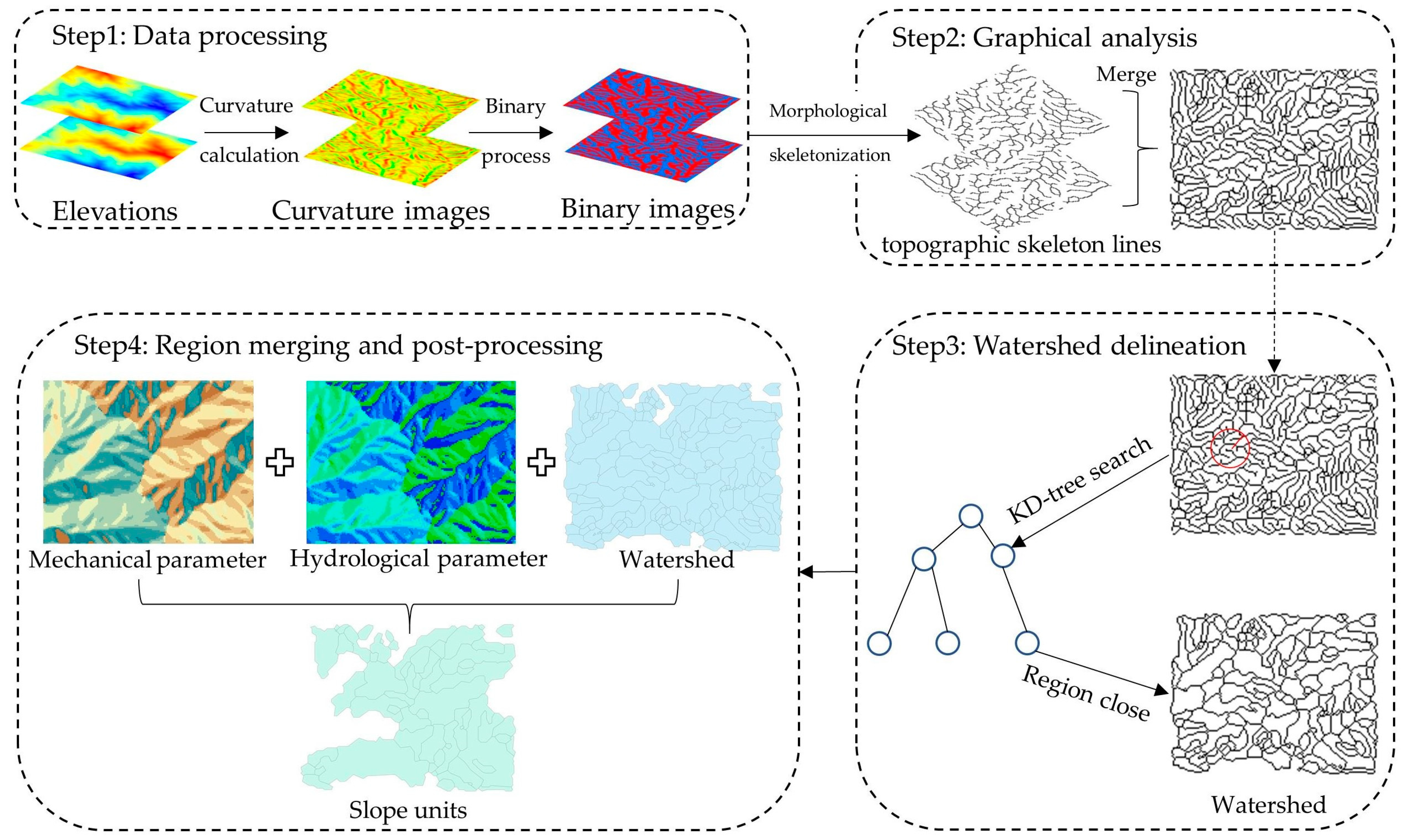
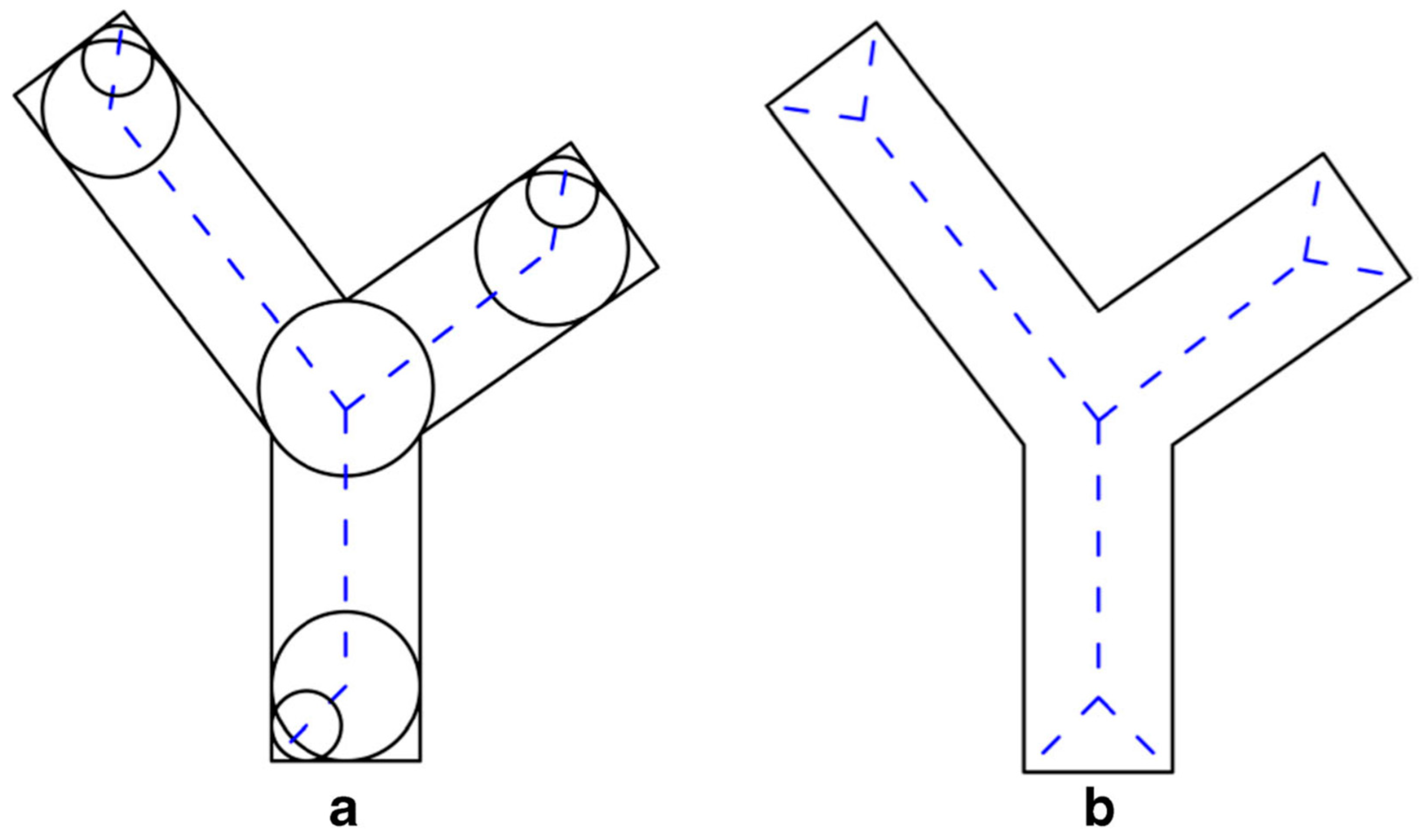
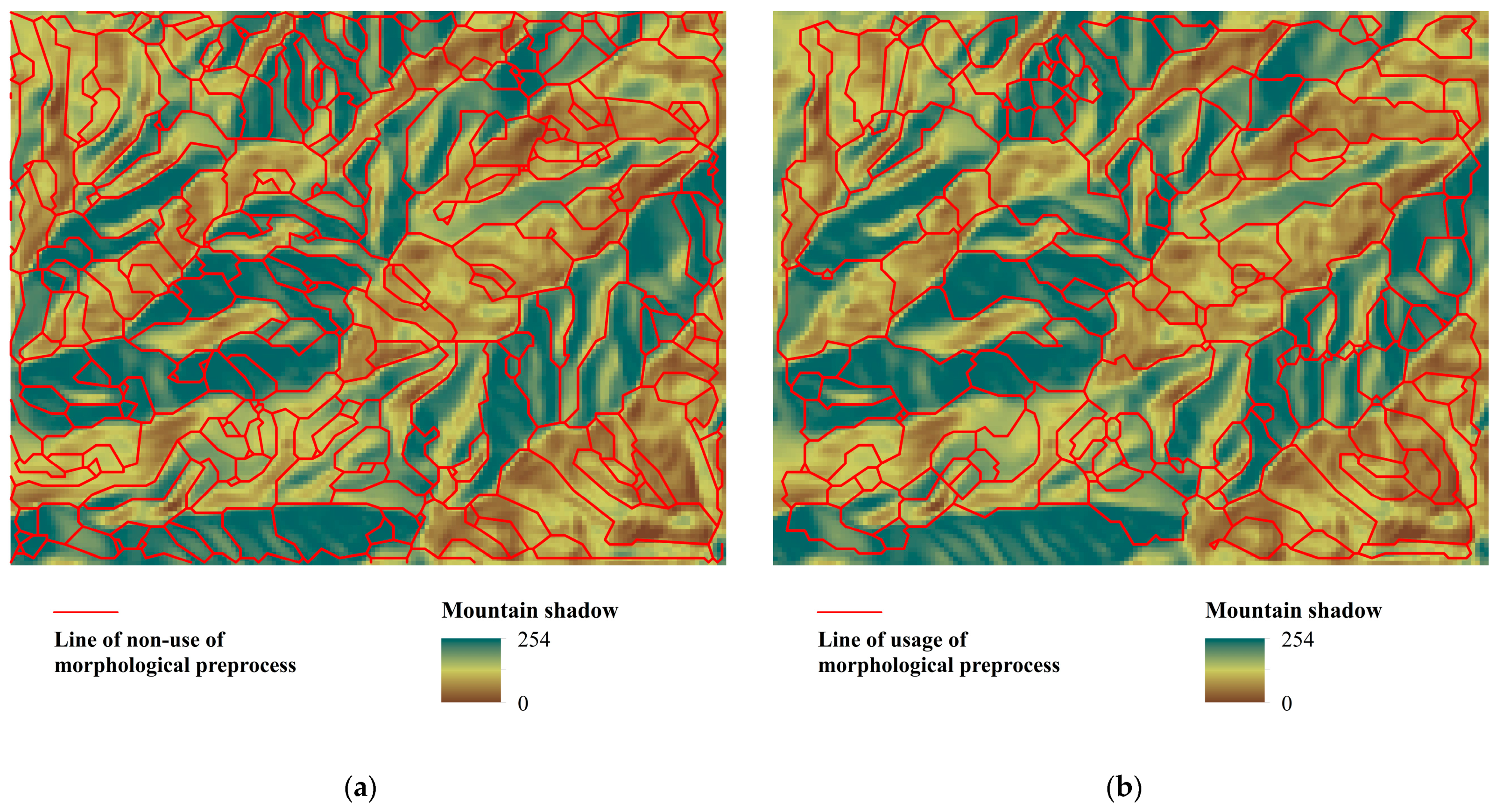
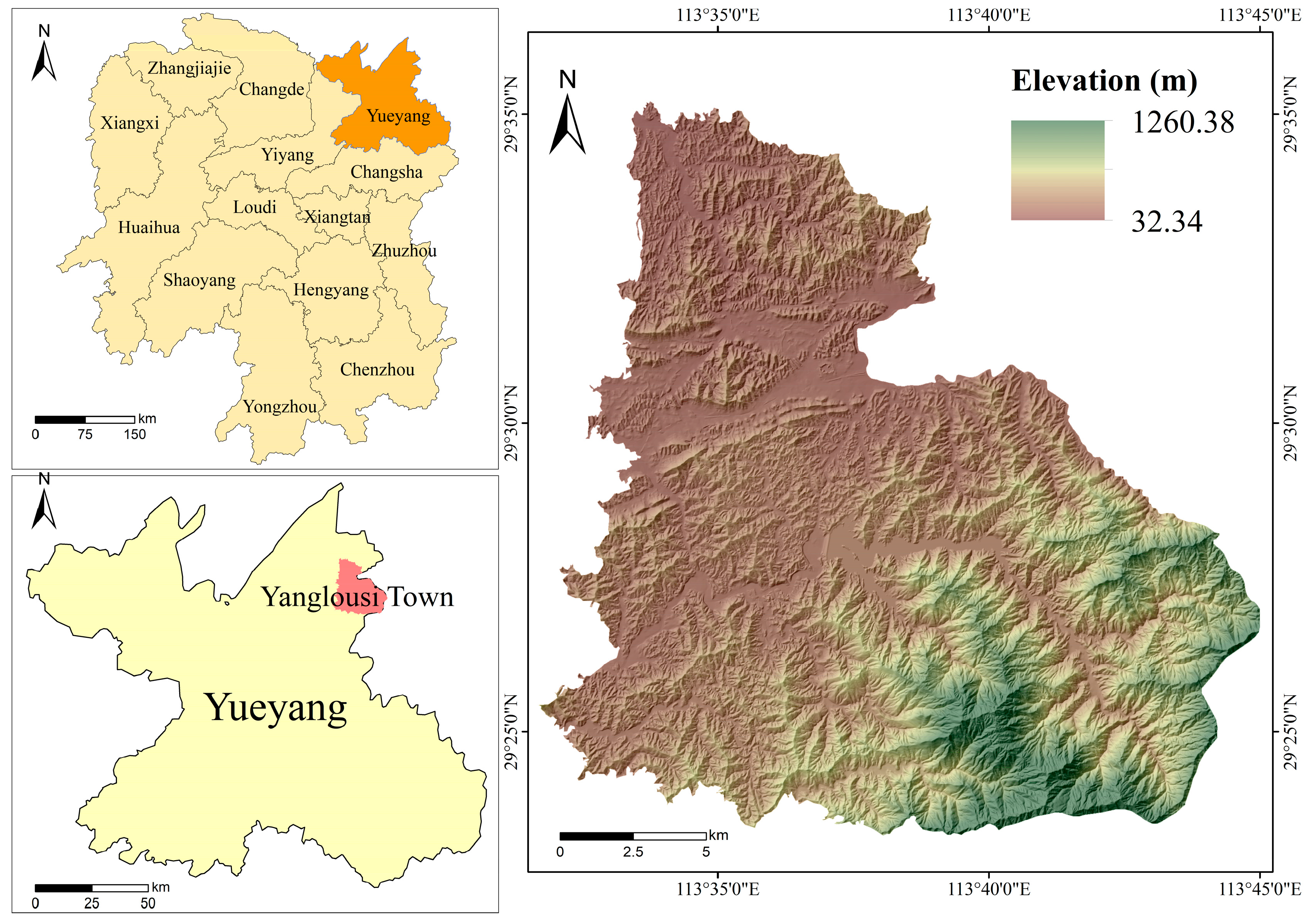
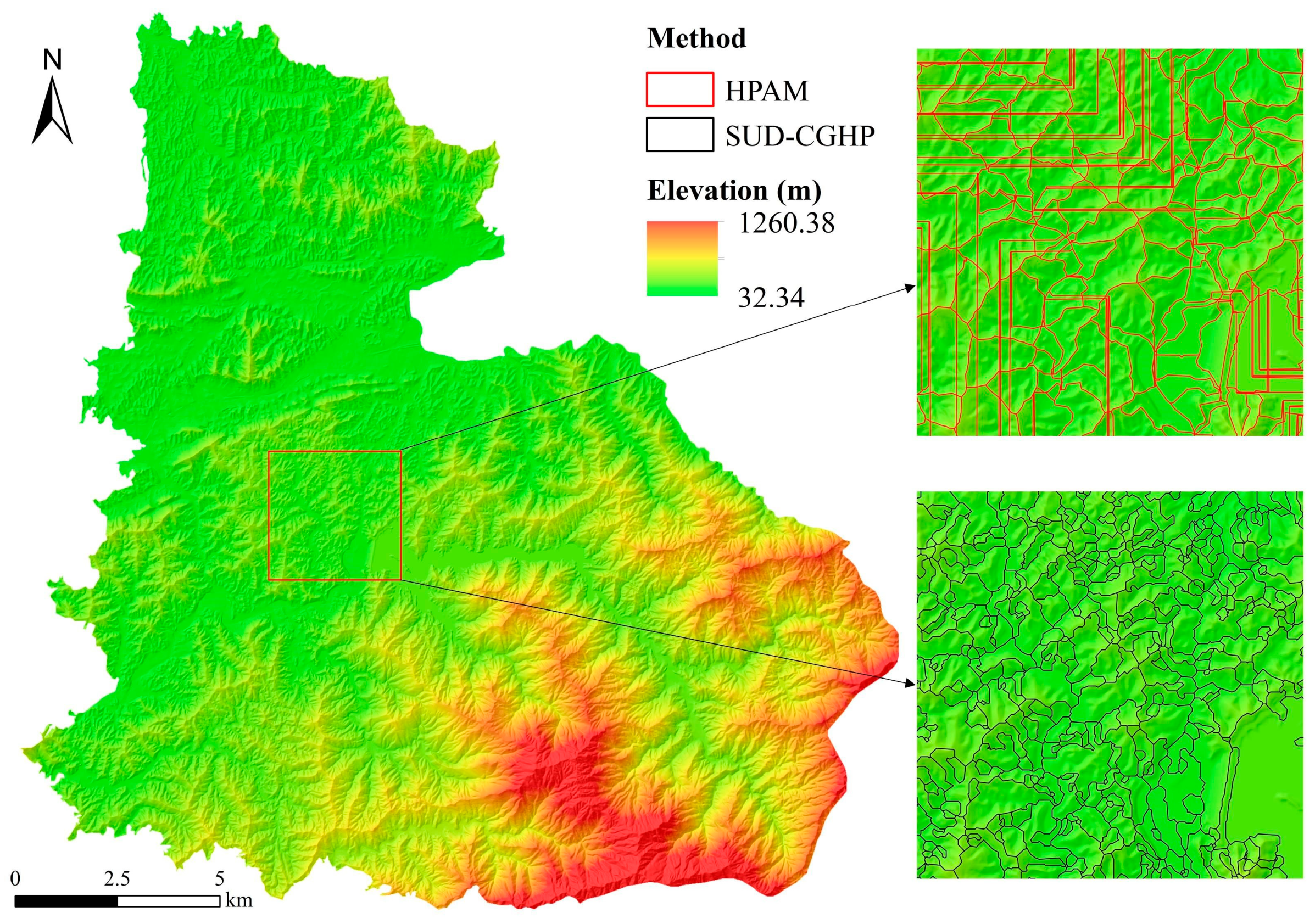
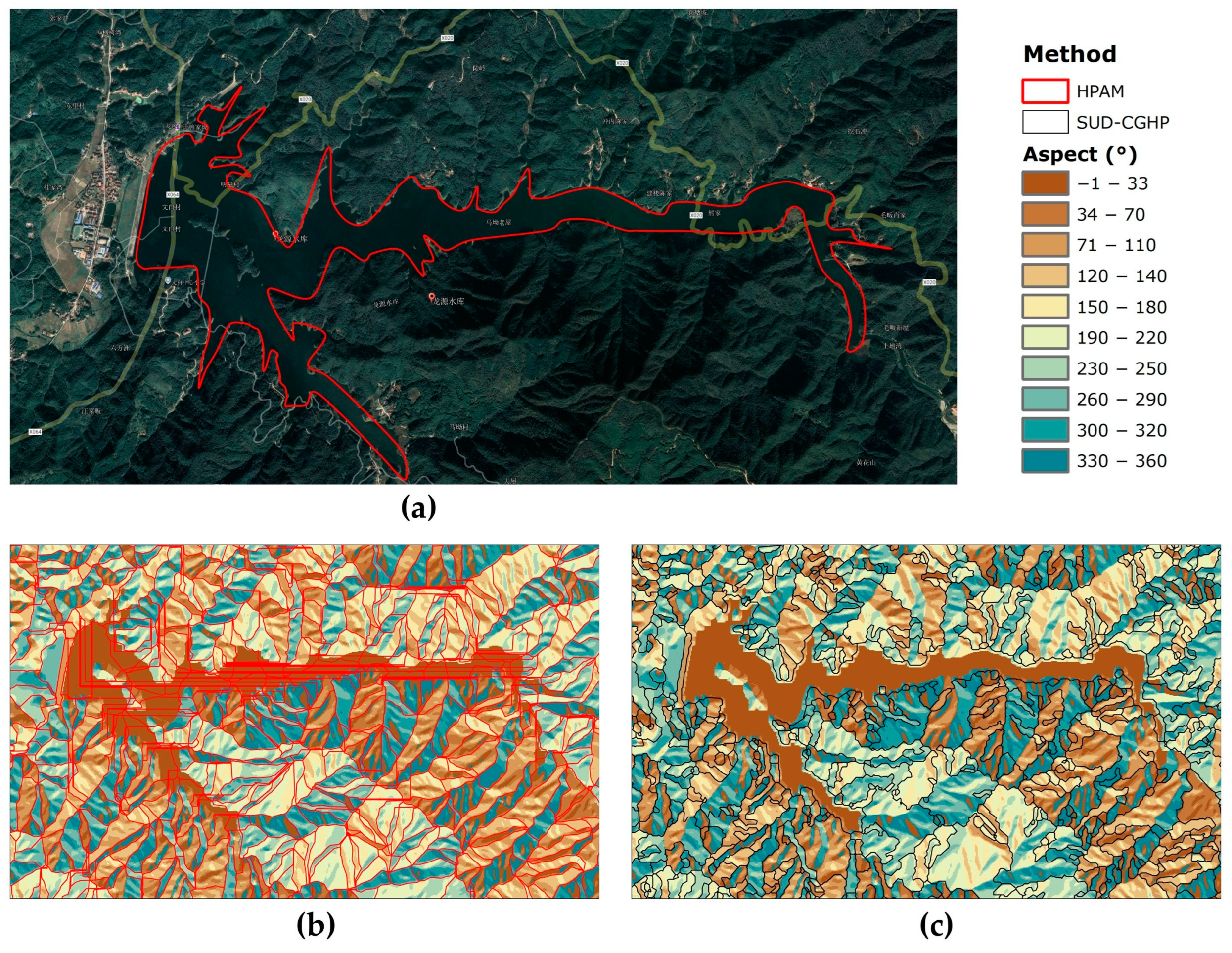
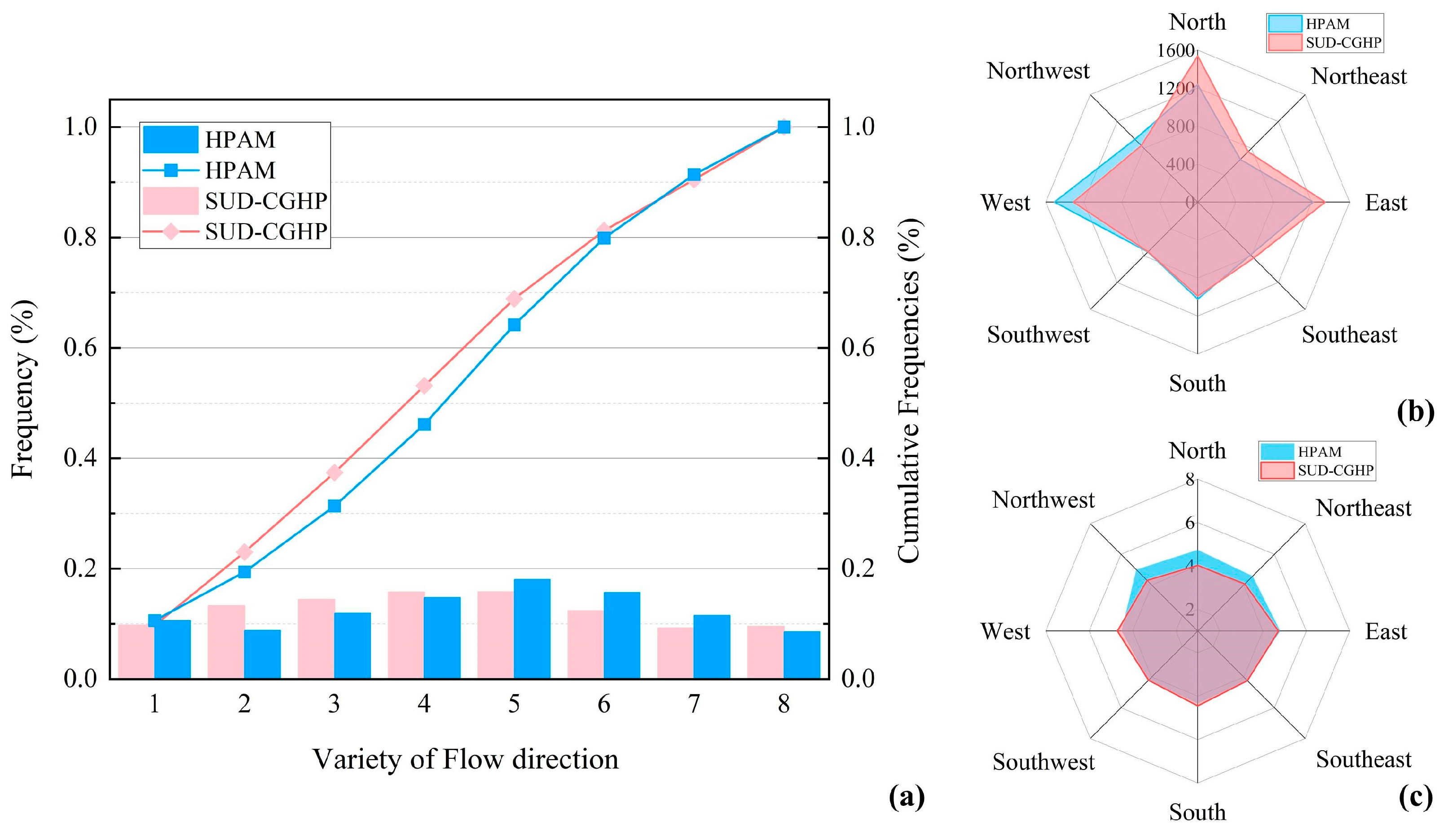

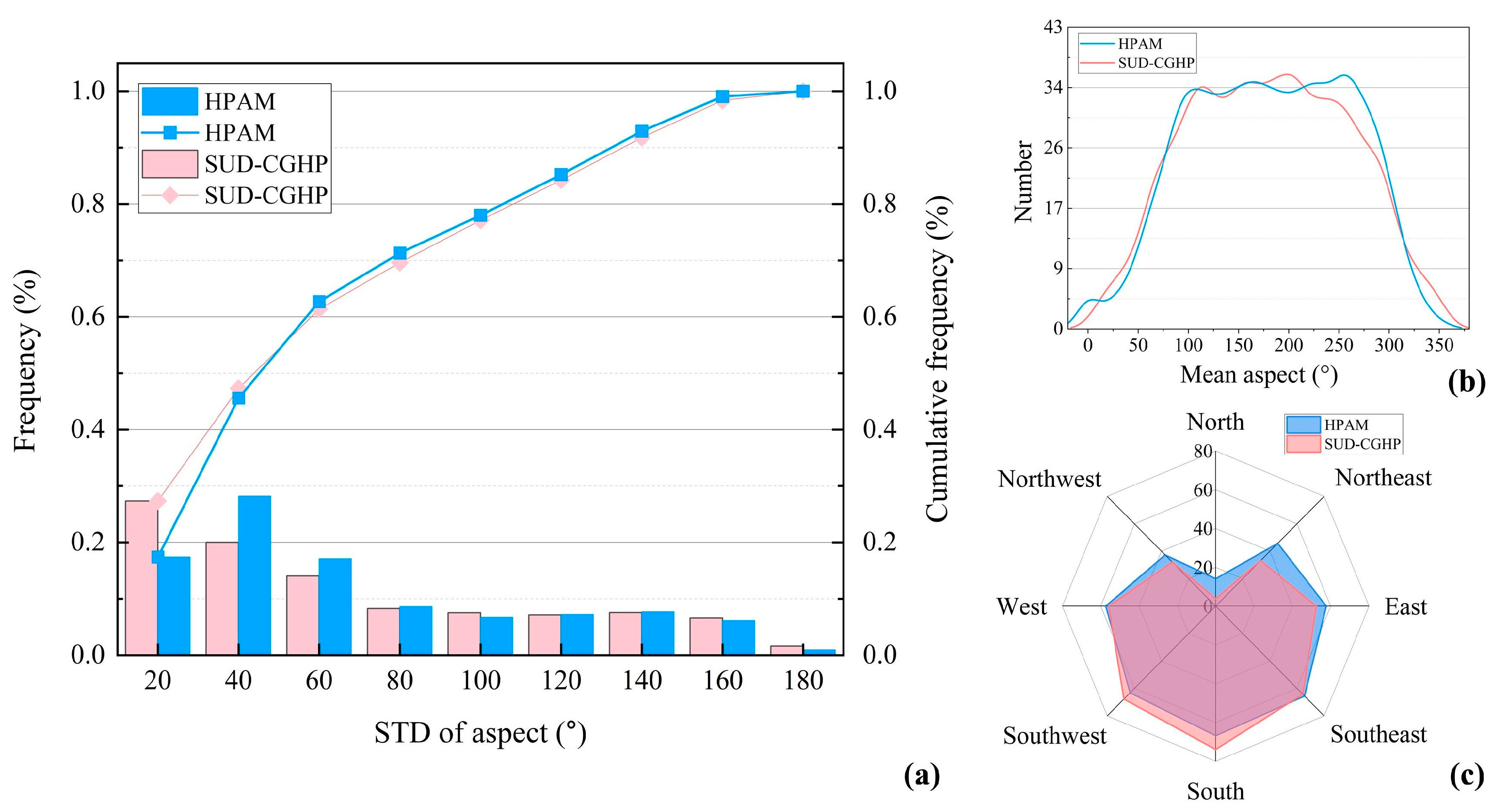
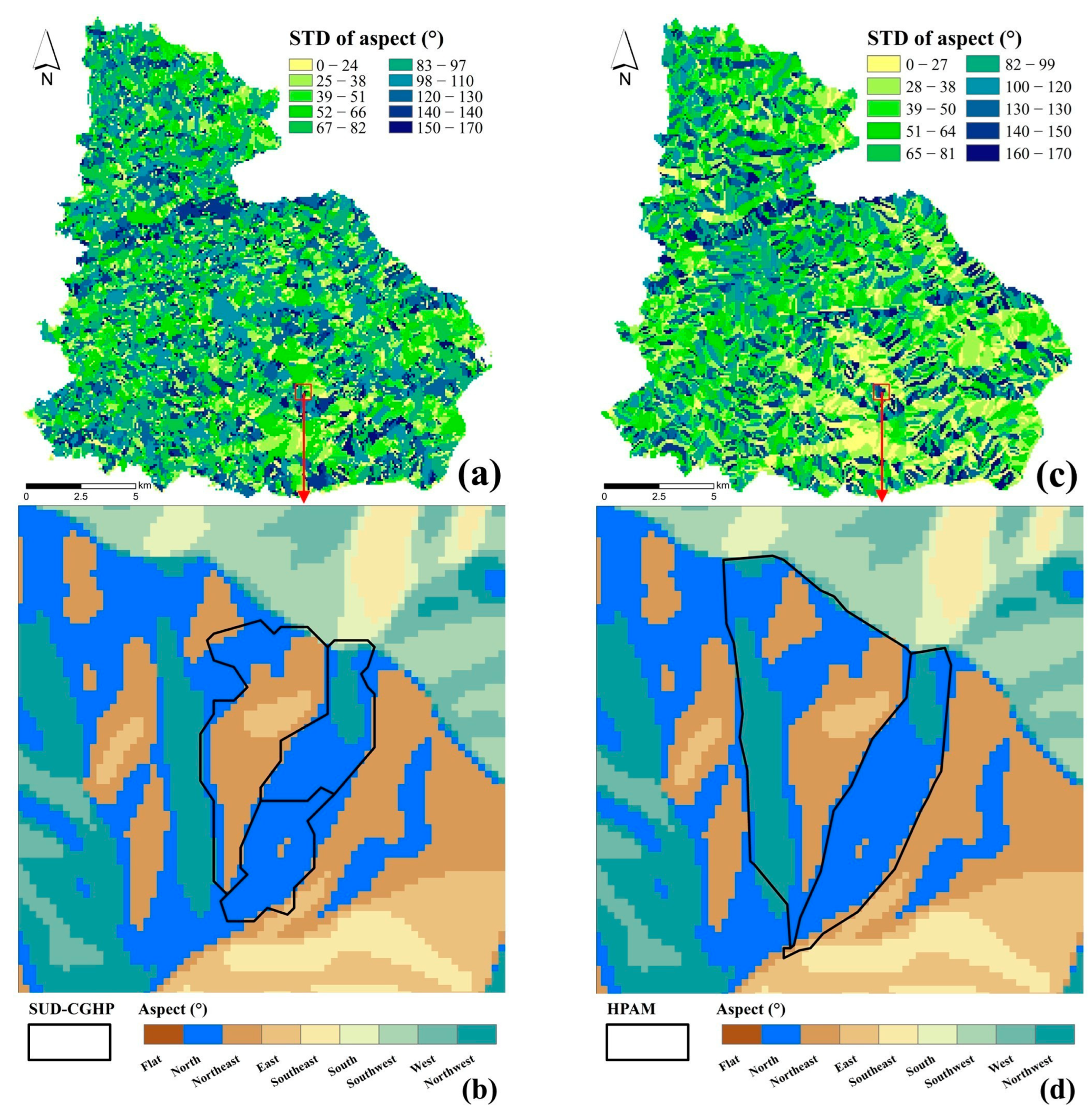
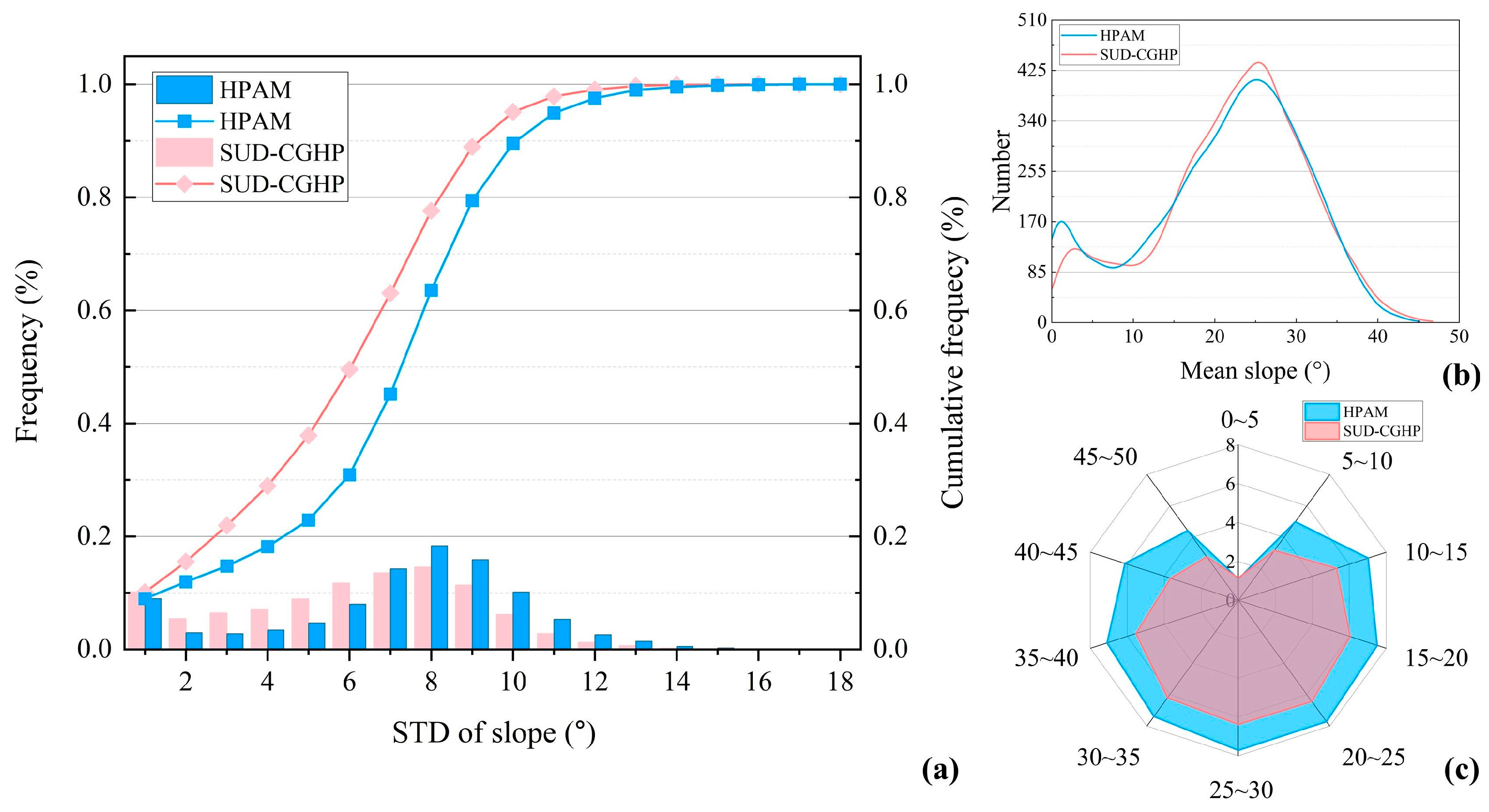

Disclaimer/Publisher’s Note: The statements, opinions and data contained in all publications are solely those of the individual author(s) and contributor(s) and not of MDPI and/or the editor(s). MDPI and/or the editor(s) disclaim responsibility for any injury to people or property resulting from any ideas, methods, instructions or products referred to in the content. |
© 2025 by the authors. Licensee MDPI, Basel, Switzerland. This article is an open access article distributed under the terms and conditions of the Creative Commons Attribution (CC BY) license (https://creativecommons.org/licenses/by/4.0/).
Share and Cite
Xiao, T.; Zhu, L.; Wang, L.; Yang, B.; Wang, C.; Yao, H. An Automated and Efficient Slope Unit Division Method Coupled with Computer Graphics and Hydrological Principles. Appl. Sci. 2025, 15, 4647. https://doi.org/10.3390/app15094647
Xiao T, Zhu L, Wang L, Yang B, Wang C, Yao H. An Automated and Efficient Slope Unit Division Method Coupled with Computer Graphics and Hydrological Principles. Applied Sciences. 2025; 15(9):4647. https://doi.org/10.3390/app15094647
Chicago/Turabian StyleXiao, Ting, Li Zhu, Lichang Wang, Beibei Yang, Can Wang, and Haipeng Yao. 2025. "An Automated and Efficient Slope Unit Division Method Coupled with Computer Graphics and Hydrological Principles" Applied Sciences 15, no. 9: 4647. https://doi.org/10.3390/app15094647
APA StyleXiao, T., Zhu, L., Wang, L., Yang, B., Wang, C., & Yao, H. (2025). An Automated and Efficient Slope Unit Division Method Coupled with Computer Graphics and Hydrological Principles. Applied Sciences, 15(9), 4647. https://doi.org/10.3390/app15094647






